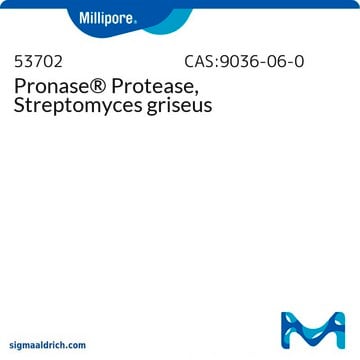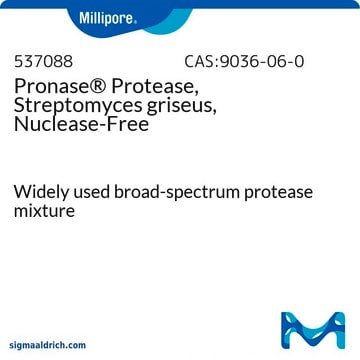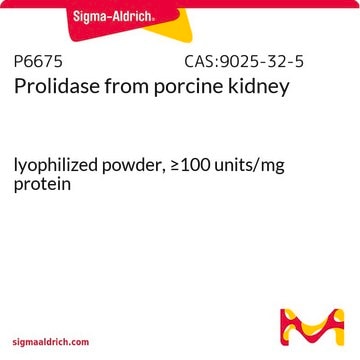Kluczowe dokumenty
PRON-RO
Roche
Pronase
from Streptomyces griseus
Synonim(y):
non-specific protease
Wybierz wielkość
858,00 zł
Wybierz wielkość
About This Item
858,00 zł
Polecane produkty
pochodzenie biologiczne
Streptomyces griseus
Poziom jakości
sterylność
non-sterile
Formularz
lyophilized powder
opakowanie
pkg of 1 g (10165921001)
pkg of 5 g (11459643001)
producent / nazwa handlowa
Roche
stężenie
0.5-2 mg/mL
Parametry
35-40 °C optimum reaction temp.
metody
DNA extraction: suitable
kolor
white
optymalne pH
7.0-8.0
zakres pH
6.0-9.0
rozpuszczalność
water: soluble 10-20 g/L
przydatność
suitable for molecular biology
numer dostępu NCBI
Zastosowanie
life science and biopharma
obecność zanieczyszczeń
Deoxyribonuclease <0.002 U/mg ( based on lyoph.)
Ribonuclease <0.002 U/mg ( based on lyoph.)
temp. przechowywania
2-8°C
informacje o genach
Streptomyces griseus ... SGR_RS27460(6214424)
Powiązane kategorie
Opis ogólny
Specyficzność
Zastosowanie
Działania biochem./fizjol.
Definicja jednostki
Uwaga dotycząca przygotowania
The preparation contains 20% calcium acetate for stability. It is free of starch as per the current Quality Control Procedures.The activity of a diluted solution containing 0.01–0.1 M calcium was stable over 24 hours at neutral pH at 4 to 8 °C. Pronase is also protected from heat inactivation by low levels of calcium.
Working concentration: 0.5 to 2 mg/ml
Working solution: Solvent is recommended in distilled water.
Stock solution is prepared by adding pronase powder to distilled water (10 to 20 mg/ml).
Storage conditions (working solution): -15 to -25 °C
Rekonstytucja
Przechowywanie i stabilność
Inne uwagi
Hasło ostrzegawcze
Danger
Zwroty wskazujące rodzaj zagrożenia
Zwroty wskazujące środki ostrożności
Klasyfikacja zagrożeń
Eye Irrit. 2 - Resp. Sens. 1 - Skin Irrit. 2 - STOT SE 3
Organy docelowe
Respiratory system
Kod klasy składowania
11 - Combustible Solids
Klasa zagrożenia wodnego (WGK)
WGK 1
Temperatura zapłonu (°F)
does not flash
Temperatura zapłonu (°C)
does not flash
Wybierz jedną z najnowszych wersji:
Masz już ten produkt?
Dokumenty związane z niedawno zakupionymi produktami zostały zamieszczone w Bibliotece dokumentów.
Klienci oglądali również te produkty
Nasz zespół naukowców ma doświadczenie we wszystkich obszarach badań, w tym w naukach przyrodniczych, materiałoznawstwie, syntezie chemicznej, chromatografii, analityce i wielu innych dziedzinach.
Skontaktuj się z zespołem ds. pomocy technicznej















